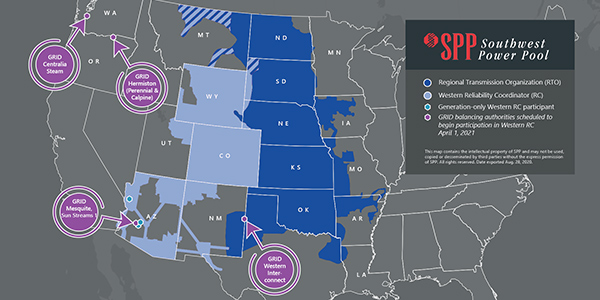Still in its first year as a reliability coordinator in the Western Interconnection, SPP on Tuesday announced it will add 3.45 GW of generating capacity to its RC footprint in 2021.
The RTO said it will add eight generating resources that are part of Gridforce Energy Management’s balancing authority in Washington, Oregon, Arizona, and New Mexico, effective April 1.
Gridforce operates primarily as a BA for independent power producers and electric utilities, but the company offers a range of other operational services. Three of its Arizona BAs are currently in SPP’s RC footprint: Griffith Energy, Arlington Valley and New Harquahala Generating Co.
Gridforce President C.J. Ingersoll said the company’s continued relationship with SPP will help its expansion and growth.
“Gridforce will continue to work with clients that receive reliability coordinator services from both SPP and [CAISO’s] RC West,” he said in a press release. “We are looking forward to continued focus on reliable system operations and the benefits of working with highly capable RCs.”
SPP launched its Western RC service in December 2019 for Gridforce and 14 other customers. It has been an RC provider in the Eastern Interconnection since 1998.
“We’re happy to see our reputation as a service provider of choice growing in the West,” said Bruce Rew, SPP’s senior vice president of operations. “We want the chance to prove ourselves just as we’ve done for Eastern utilities.”
Stakeholders Complete Work on WEIS Tariff
SPP is also developing a real-time balancing market in the West that is scheduled to launch Feb. 1. On Wednesday, the RTO’s Western stakeholders approved a final necessary revision request as staff work to refile with FERC a proposed Tariff for its Western Energy Imbalance Service (WEIS).
The measure (WRR6) completes the RTO’s response to a series of issues the commission raised in rejecting its first attempt (ER20-1059, ER20-1060). (See FERC Rejects SPP’s WEIS Tariff.)
WRR6 provides that SPP will include constraints in its economic dispatch engine to use the combined transmission capability made available by market participants (MPs) and participating BAs on transmission facilities within a participating BA area or on transmission facilities used to transfer energy between participating BAs.
The revision was a holdover from last week, when the Western Markets Working Group and Western Markets Executive Committee held two joint meetings. The stakeholder groups were able to pass three other WRRs. (See SPP Stakeholders Agree on WEIS Tariff Changes.)
Both groups passed WRR6 unanimously after agreeing on language that clarified that “SPP, in its capacity as market operator,” would, before constraining market dispatch, receive communication from joint dispatch transmission service providers and other MPs.
FERC said any future WEIS market proposal “should include the mechanisms or agreements that will ensure that the SPP WEIS market respects the transmission capacity of nonparticipating entities with appropriate constraints in the [security-constrained economic dispatch].”
Much of the debate centered on whether or not to capitalize “market operator,” as it is not defined in the WEIS’ Tariff or protocols, and how Robert’s Rules of Order governed WRR6 motions from the week before.
“I’ll be an expert on Robert’s Rules one day,” joked Basin Electric Power Cooperative’s Valerie Weigel, the working group’s chair.
SPP staff said they likely need the Board of Directors’ authorization to refile the Tariff. They plan to first meet with FERC staff for a prefiling meeting later this month before scheduling a board meeting.





